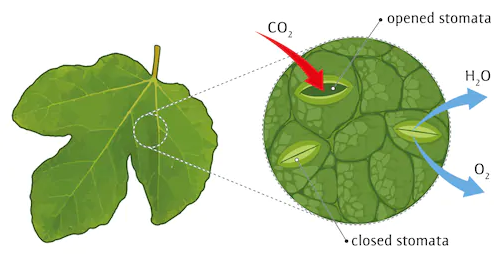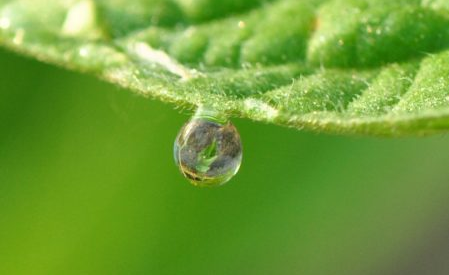What Are Stomata?
Stomata are tiny openings or pores in plant tissue that allow for gas exchange. Stomata are typically found in plant leaves but can also be found in some stems. A large number of the stomata are located on the underside of plant leaves reducing their exposure to heat and air current. Stomata are surrounded by specialized cells referred to as guard cells whose main function is to open and close stomatal pores. Stomata play an important role of allowing a plant to take in carbon dioxide which is essential for photosynthesis. More importantly, stomata remain closed during hot and dry season to minimize water loss from the plant.

Stomata can be grouped into different types based on the number and characteristics of the surrounding specialized cells. Examples of different types of stomata include:
- Anomocytic Stomata
- Anisocytic Stomata
- Diacytic Stomata
- Paracytic Stomata
- Gramineous Stomata
What Are Hydathodes?
Hydathodes also referred to as water stomata is a type of pore commonly found in angiosperms that secretes water through pores in the epidermis or leaf margin, typically at the tip of the marginal tooth or serration. Hydathodes are connected to the plant vascular system by a vascular bundle. They are made of a group of living cells with numerous intercellular spaces filled with water, but few or no chloroplasts and represent modified bundle-ends.

Hydathodes are commonly seen in water lettuce, water hyacinth, rose and balsam. They also occur in leaves of submerged aquatic plants such as Ranunculus fluitans and herbaceous plants of drier habitats such as Campanula rotundifolia.
It is also important to note that, hydathodes are very much involved in the process of guttation, in which positive xylem pressure (due to root pressure) causes liquid to exude from the pores. Hydathodes can be categorized into two types:
- Active hydathodes (formed when epidermal cells lose water actively).
- Passive hydathodes (formed when a leaf vein terminates in an epithem-an area of thin-walled parenchyma).
Also Read: Difference Between Transpiration And Guttation
Difference Between Stomata And Hydathodes In Tabular Form
| BASIS OF COMPARISON | STOMATA | HYDATHODES |
| Description | Stomata are tiny openings or pores in plant tissue that allow for gas exchange. Stomata are typically found in plant leaves but can also be found in some stems. | Hydathodes also referred to as water stomata is a type of pore commonly found in angiosperms that secretes water through pores in the epidermis or leaf margin, typically at the tip of the marginal tooth or serration. |
| Location | Stomata are found on the surfaces of both the epidermis of leaf and on the young parts of the stem, fruits, flowers etc. | Hydathodes occur on the margins and tips of the leaves. |
| Presence | Stomata are found in the aerial parts of all land plants. | Hydathodes are present on the leaves of only a few plants. |
| Types | Anomocytic StomataAnisocytic StomataDiacytic StomataParacytic StomataGramineous Stomata | Active hydathodes Passive hydathodes |
| Role | Stomata facilitate exchange of gases like oxygen and carbon dioxide. | Hydathodes do not play any role in gaseous exchange in plants. |
| Chloroplast | The guard cells surrounding the stomata contain chloroplasts. | The cells surrounding the hydathodes do not contain chloroplasts. |
| Opening And Closing | Stomata remain opened during day time and closed during night time. | Hydathodes remain open during both night and day time. |
| Regulation of Opening & closing Mechanism | The mechanism of opening and closing of stomata can be controlled guard cells. | The closing and opening mechanism is absent in hydathodes and therefore they always remain closed. |
| Relation With Vein Ends Of The Leaves | The stomata do not have any functional relation with the vein ends of the leaves. | Hydathodes have a functional relationship with the vein ends of the leaves. |
| Subsidiary Cells | Stomata are usually enmeshed between many subsidiary cells. | The hydathodes are not surrounded with subsidiary cells. |
| Subtended Cavity | Stomata are subtended by a sub-stomatal cavity. | Hydathodes are subtended by a sub-epidermal cavity and a mass of loosely packed parencymatous cells referred to as Epithem. |
| Surrounding Cells | Stomata are surrounded by a pair of specialized epidermal cells referred to as Guard cells. | Hydathodes are surrounded by a ring of non-specialized cells. |
| What They Pass Out | Stomata pass out water vapour. | Hydathode passes out liquid water. |
| Processes Involved In | Stomata are involved in Transpiration and exchange of gases. | Hydathodes are involved in guttation. |